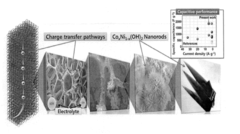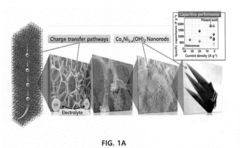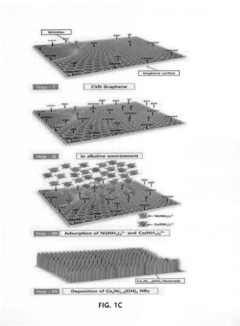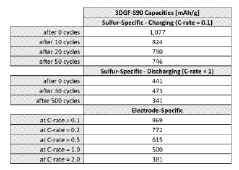Breakthroughs: Graphene Oxide in Supercapacitor Design
Graphene Oxide Supercapacitor Evolution
The evolution of graphene oxide in supercapacitor design has been marked by significant breakthroughs and continuous advancements. Initially, researchers recognized the potential of graphene oxide as a promising material for supercapacitor electrodes due to its high surface area and excellent electrical properties.
In the early stages of development, scientists focused on optimizing the synthesis methods of graphene oxide to enhance its performance in supercapacitors. The Hummers method, which involves the oxidation of graphite, was refined to produce high-quality graphene oxide with improved conductivity and surface area.
As research progressed, the focus shifted towards modifying graphene oxide to overcome its inherent limitations. One significant breakthrough was the development of reduced graphene oxide (rGO), which exhibited enhanced electrical conductivity while maintaining a high surface area. This advancement led to improved energy storage capabilities in supercapacitors.
The incorporation of heteroatoms, such as nitrogen and boron, into the graphene oxide structure marked another milestone. These doped graphene oxide materials demonstrated superior electrochemical performance, including increased capacitance and improved cycling stability.
Researchers also explored the creation of graphene oxide-based composite materials. By combining graphene oxide with conductive polymers, metal oxides, or carbon nanotubes, they were able to synergistically enhance the overall performance of supercapacitors.
The development of three-dimensional graphene oxide architectures represented a significant leap forward. These structures, including aerogels and foams, provided increased surface area and improved ion transport pathways, resulting in higher energy and power densities.
Recent advancements have focused on the precise control of graphene oxide's pore structure and surface chemistry. Techniques such as template-assisted synthesis and chemical activation have enabled the creation of graphene oxide materials with tailored pore sizes and distributions, optimizing the balance between energy storage and power delivery.
The integration of graphene oxide into flexible and wearable supercapacitors has opened up new avenues for energy storage in portable electronics. Researchers have developed methods to fabricate graphene oxide-based electrodes on flexible substrates, paving the way for bendable and stretchable energy storage devices.
As the field continues to evolve, ongoing research is exploring the potential of graphene oxide in hybrid supercapacitor systems, combining the high power density of supercapacitors with the high energy density of batteries. This approach aims to bridge the gap between these two energy storage technologies, offering devices with both rapid charging capabilities and extended energy storage capacity.
Market Demand Analysis
The market demand for graphene oxide in supercapacitor design has been experiencing significant growth in recent years, driven by the increasing need for high-performance energy storage solutions across various industries. Supercapacitors, known for their rapid charge-discharge capabilities and long cycle life, are finding applications in sectors such as automotive, consumer electronics, renewable energy, and industrial systems.
The automotive industry represents a major market for graphene oxide-based supercapacitors. With the shift towards electric and hybrid vehicles, there is a growing demand for energy storage systems that can provide quick bursts of power for acceleration and regenerative braking. Graphene oxide's exceptional electrical conductivity and large surface area make it an ideal material for enhancing supercapacitor performance in these applications.
In the consumer electronics sector, the trend towards smaller, more powerful devices has created a need for compact energy storage solutions. Graphene oxide-enhanced supercapacitors offer the potential for faster charging times and longer battery life in smartphones, laptops, and wearable devices. This market segment is expected to be a significant driver of demand for graphene oxide in supercapacitor design.
The renewable energy sector is another key area driving market demand. As the world transitions to cleaner energy sources, there is an increasing need for efficient energy storage systems to manage the intermittent nature of renewable power generation. Graphene oxide-based supercapacitors can play a crucial role in grid stabilization and energy management for solar and wind power installations.
Industrial applications, including power tools, backup power systems, and heavy machinery, are also contributing to the growing demand for graphene oxide in supercapacitors. These applications require energy storage solutions that can deliver high power output and withstand frequent charge-discharge cycles, making graphene oxide-enhanced supercapacitors an attractive option.
The market for graphene oxide in supercapacitor design is expected to expand further as research and development efforts continue to improve the material's properties and manufacturing processes. Advancements in scalable production methods and cost reduction strategies are likely to drive wider adoption across various industries.
As environmental concerns and energy efficiency regulations become more stringent, the demand for high-performance, sustainable energy storage solutions is expected to increase. Graphene oxide's potential to enhance the performance and sustainability of supercapacitors positions it well to meet these evolving market needs.
Technical Challenges
Despite the promising potential of graphene oxide in supercapacitor design, several significant technical challenges persist in its practical implementation. One of the primary obstacles is the difficulty in achieving uniform dispersion of graphene oxide sheets within the electrode material. The tendency of graphene oxide to agglomerate due to strong van der Waals forces between layers can lead to reduced surface area and diminished capacitance performance.
Another critical challenge lies in controlling the oxygen-containing functional groups on graphene oxide surfaces. While these groups contribute to enhanced hydrophilicity and improved electrolyte accessibility, they can also negatively impact the electrical conductivity of the material. Striking the right balance between functionalization and conductivity remains a complex task that requires precise engineering at the molecular level.
The scalability of graphene oxide production for large-scale supercapacitor manufacturing presents another significant hurdle. Current synthesis methods often yield inconsistent quality and limited quantities, making it difficult to maintain uniform performance across batches. Additionally, the high cost associated with producing high-quality graphene oxide poses a barrier to widespread commercial adoption.
Stability issues during long-term cycling also pose a considerable challenge. The repeated charge-discharge cycles can lead to structural degradation of graphene oxide-based electrodes, resulting in capacity fading and reduced cycle life. Addressing this requires the development of more robust electrode architectures and improved understanding of the degradation mechanisms at play.
Furthermore, the environmental impact and potential toxicity of graphene oxide production and disposal need careful consideration. Developing eco-friendly synthesis methods and establishing proper handling and disposal protocols are essential for the sustainable implementation of this technology.
Lastly, integrating graphene oxide into existing supercapacitor manufacturing processes presents its own set of challenges. Adapting current production lines to accommodate the unique properties of graphene oxide while maintaining cost-effectiveness and efficiency requires significant research and development efforts.
Overcoming these technical challenges will be crucial for realizing the full potential of graphene oxide in supercapacitor design. Continued research efforts focusing on material optimization, scalable production techniques, and innovative electrode designs are necessary to address these obstacles and pave the way for next-generation energy storage solutions.
Current GO Solutions
01 Graphene oxide synthesis and modification for supercapacitors
Various methods for synthesizing and modifying graphene oxide to enhance its performance in supercapacitors. This includes techniques for controlling the structure, surface area, and functional groups of graphene oxide to improve its capacitance and energy storage capabilities.- Graphene oxide synthesis and modification for supercapacitors: Various methods for synthesizing and modifying graphene oxide to enhance its performance in supercapacitors. These techniques aim to improve the material's surface area, conductivity, and electrochemical properties, resulting in better energy storage capabilities.
- Electrode fabrication using graphene oxide: Techniques for fabricating electrodes using graphene oxide for supercapacitor applications. This includes methods for creating composite electrodes, optimizing electrode structure, and enhancing the interface between the electrode and electrolyte to improve overall device performance.
- Electrolyte optimization for graphene oxide supercapacitors: Development of specialized electrolytes that work synergistically with graphene oxide-based electrodes. These electrolytes are designed to enhance ion mobility, improve charge storage capacity, and increase the overall energy density of the supercapacitor.
- Graphene oxide-based hybrid materials for supercapacitors: Creation of hybrid materials combining graphene oxide with other materials such as metal oxides, conductive polymers, or carbon nanotubes. These hybrid materials aim to leverage the unique properties of each component to achieve superior supercapacitor performance.
- Performance evaluation and characterization techniques: Methods and techniques for evaluating and characterizing the performance of graphene oxide-based supercapacitors. This includes advanced analytical tools, testing protocols, and performance metrics to assess factors such as capacitance, energy density, power density, and cycle life.
02 Electrode fabrication using graphene oxide
Techniques for fabricating electrodes using graphene oxide materials for supercapacitor applications. This involves methods for creating thin films, composites, and 3D structures to maximize the surface area and conductivity of the electrodes, leading to improved supercapacitor performance.Expand Specific Solutions03 Graphene oxide-based composites for supercapacitors
Development of composite materials combining graphene oxide with other materials such as conductive polymers, metal oxides, or carbon nanotubes to enhance the overall performance of supercapacitors. These composites aim to improve conductivity, stability, and energy density.Expand Specific Solutions04 Electrolyte optimization for graphene oxide supercapacitors
Research on optimizing electrolyte compositions and properties to enhance the performance of graphene oxide-based supercapacitors. This includes studies on ionic liquids, gel electrolytes, and solid-state electrolytes to improve energy density, power density, and cycling stability.Expand Specific Solutions05 Graphene oxide supercapacitor device design and assembly
Innovative approaches to supercapacitor device design and assembly using graphene oxide materials. This encompasses strategies for optimizing cell configuration, packaging, and integration to maximize performance, durability, and scalability of graphene oxide-based supercapacitors.Expand Specific Solutions
Key Industry Players
The field of graphene oxide in supercapacitor design is in a rapidly evolving phase, characterized by intense research and development activities. The market for graphene-based supercapacitors is expanding, driven by the growing demand for high-performance energy storage solutions. While the technology is still maturing, significant progress has been made by key players such as SK Innovation Co., Ltd., Global Graphene Group, Inc., and BASF Corp. Academic institutions like the University of California and Nanyang Technological University are also contributing to advancements. The competitive landscape is diverse, with collaborations between industry and academia playing a crucial role in driving innovation and commercialization efforts.
Global Graphene Group, Inc.
BASF Corp.
Core GO Innovations
- A three-dimensional graphene composite is developed by adsorbing transition metal hydroxides, transition metal oxides, or conducting polymers onto a graphene foam, utilizing chemical bath deposition or electrodeposition methods to enhance electrostatic capacity and energy density.
- The development of graphene-based supercapacitors with a three-dimensional porous reduced graphene oxide framework, which includes a composite material with a capacitive or pseudo-capacitive material, enhancing specific surface area, porosity, and conductivity, thereby improving power density and cycle lifetime.
Environmental Impact
The integration of graphene oxide in supercapacitor design brings significant environmental implications that warrant careful consideration. While this innovative technology offers promising advancements in energy storage, its environmental impact spans various aspects of the product lifecycle.
During the production phase, the synthesis of graphene oxide involves chemical processes that may generate hazardous byproducts. These processes often require strong oxidizing agents and acids, which, if not properly managed, can lead to environmental contamination. However, recent research has focused on developing more environmentally friendly synthesis methods, such as electrochemical exfoliation, which significantly reduces the use of harmful chemicals and minimizes waste generation.
The use of graphene oxide in supercapacitors contributes to improved energy efficiency and storage capacity, potentially reducing the overall energy consumption in various applications. This efficiency gain indirectly benefits the environment by decreasing the demand for fossil fuel-based energy sources and lowering greenhouse gas emissions. Moreover, the enhanced performance of graphene oxide-based supercapacitors may lead to a reduction in the number of devices needed for certain applications, thereby minimizing electronic waste.
However, the long-term environmental effects of graphene oxide nanoparticles remain a subject of ongoing research. There are concerns about the potential release of these nanoparticles into the environment during the manufacturing, use, or disposal of supercapacitors. Studies have shown that graphene oxide can interact with living organisms and ecosystems in complex ways, with possible impacts on aquatic life and soil microorganisms. The persistence and bioaccumulation of these nanoparticles in the environment are areas that require further investigation to ensure their safe and sustainable use.
End-of-life management of graphene oxide-based supercapacitors presents both challenges and opportunities. On one hand, the complex composition of these devices may complicate recycling processes. On the other hand, the high value of graphene oxide and other components could incentivize the development of advanced recycling technologies, promoting a circular economy approach in the electronics industry.
To address these environmental concerns, researchers and manufacturers are exploring various strategies. These include developing green synthesis methods for graphene oxide, designing easily recyclable supercapacitor structures, and implementing strict controls to prevent nanoparticle release during production and use. Additionally, life cycle assessments are being conducted to comprehensively evaluate the environmental footprint of graphene oxide-based supercapacitors, from raw material extraction to final disposal.
Scalability Considerations
Scalability considerations are crucial when evaluating the potential of graphene oxide in supercapacitor design for large-scale applications. The transition from laboratory-scale production to industrial-scale manufacturing presents several challenges that must be addressed to ensure the viability of graphene oxide-based supercapacitors in commercial settings.
One of the primary concerns is the production of high-quality graphene oxide in large quantities. Current synthesis methods, such as the modified Hummers' method, are effective for small-scale production but may face limitations when scaled up. Researchers are exploring alternative production techniques, including electrochemical exfoliation and chemical vapor deposition, to overcome these challenges and achieve consistent quality at industrial scales.
The integration of graphene oxide into supercapacitor electrodes on a large scale also presents technical hurdles. Maintaining uniform dispersion and preventing agglomeration of graphene oxide sheets during the electrode fabrication process is critical for optimal performance. Advanced coating and deposition techniques, such as spray coating and electrophoretic deposition, are being developed to address these issues and ensure consistent electrode quality in mass production.
Cost considerations play a significant role in scalability. While graphene oxide offers superior performance, the production costs must be competitive with existing materials to justify widespread adoption. Efforts are underway to optimize production processes, reduce raw material costs, and improve yield to make graphene oxide-based supercapacitors economically viable for large-scale applications.
Environmental and safety concerns also factor into scalability considerations. The production of graphene oxide often involves the use of strong oxidizing agents and acids, which can pose environmental risks if not properly managed. Developing greener synthesis methods and implementing effective waste management strategies are essential for sustainable large-scale production.
Standardization is another critical aspect of scalability. Establishing industry-wide standards for graphene oxide quality, characterization methods, and performance metrics is necessary to ensure consistency across different manufacturers and applications. This standardization will facilitate quality control and enable more straightforward integration of graphene oxide-based supercapacitors into various products and systems.
Lastly, the scalability of graphene oxide in supercapacitor design also depends on the availability of specialized equipment and expertise. Investing in advanced manufacturing facilities and training a skilled workforce are essential steps in transitioning from laboratory-scale research to industrial-scale production. Collaboration between academic institutions, research centers, and industry partners can accelerate this process and address the multifaceted challenges of scaling up graphene oxide-based supercapacitor technology.







